HONDA CR-Z 2012 1.G Owners Manual
Manufacturer: HONDA, Model Year: 2012, Model line: CR-Z, Model: HONDA CR-Z 2012 1.GPages: 333, PDF Size: 10.43 MB
Page 311 of 333
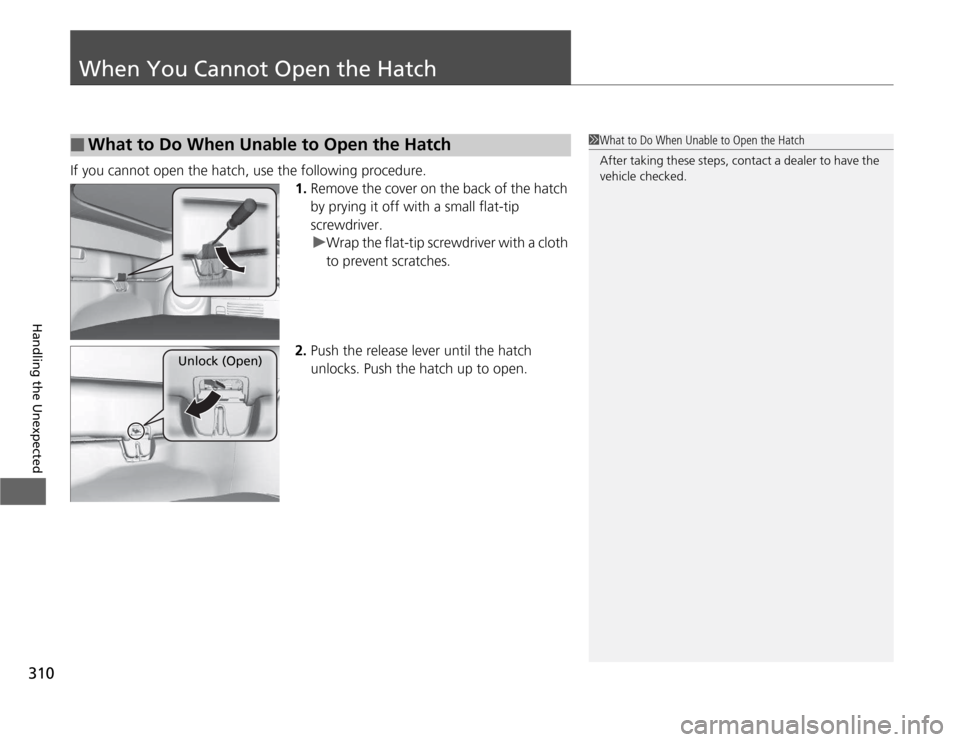
310
Handling the Unexpected
When You Cannot Open the Hatch
If you cannot open the hatch, use the following procedure.1.Remove the cover on the back of the hatch
by prying it off with a small flat-tip
screwdriver.
uWrap the flat-tip screwdriver with a cloth
to prevent scratches.
2. Push the release lever until the hatch
unlocks. Push the hatch up to open.
■What to Do When Unable to Open the Hatch1What to Do When Unable to Open the Hatch
After taking these steps, contact a dealer to have the
vehicle checked.
Unlock (Open)
Page 312 of 333
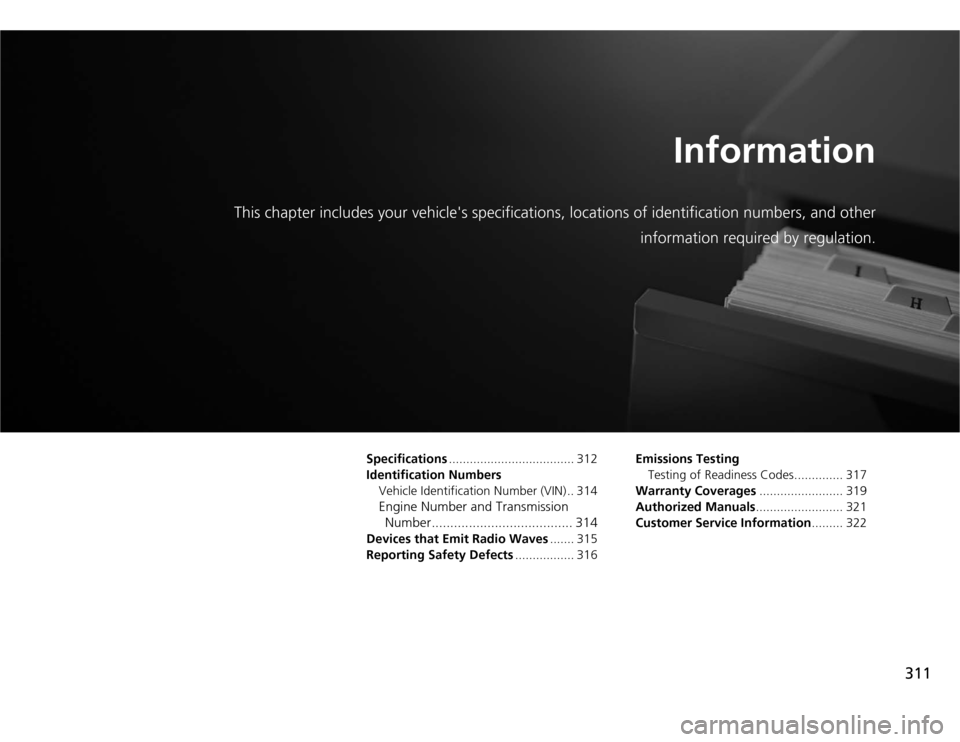
311
Information
This chapter includes your vehicle's specifications, locations of identification numbers, and other
information re quired by regulation.
Specifications.................................... 312
Identification Numbers Vehicle Identification Number (VIN) .. 314
Engine Number and Transmission
Number.......... ............................ 314
Devices that Emit Radio Waves ....... 315
Reporting Safety Defects ................. 316Emissions Testing
Testing of Readiness Codes.............. 317
Warranty Coverages ........................ 319
Authorized Manuals ......................... 321
Customer Service Information ......... 322
Page 313 of 333
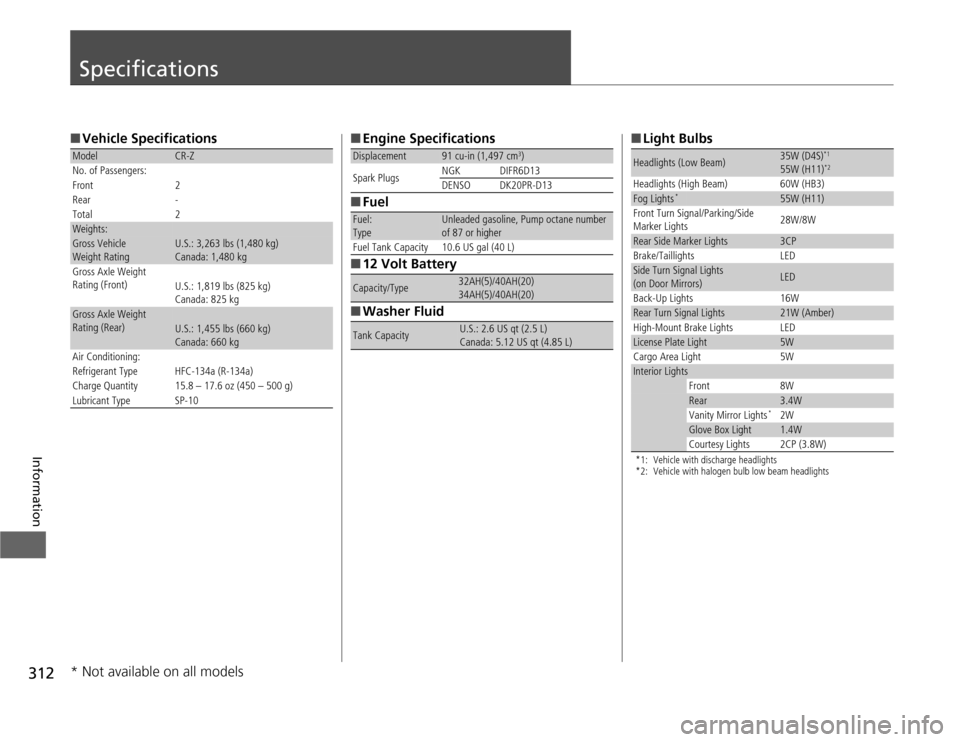
312
Information
Specifications
■Vehicle Specifications
ModelCR-Z
No. of Passengers:
Front 2
Rear -
Total 2
Weights:
Gross Vehicle
Weight Rating U.S.: 3,263 lbs (1,480 kg)
Canada: 1,480 kg
Gross Axle Weight
Rating (Front)
U.S.: 1,819 lbs (825 kg)
Canada: 825 kg
Gross Axle Weight
Rating (Rear)
U.S.: 1,455 lbs (660 kg)
Canada: 660 kg
Air Conditioning:
Refrigerant Type HFC-134a (R-134a)
Charge Quantity 15.8 – 17.6 oz (450 – 500 g)
Lubricant Type SP-10
■Engine Specifications
■Fuel
■12 Volt Battery
■Washer Fluid
Displacement91 cu-in (1,497 cm 3
)
Spark Plugs NGK DIFR6D13
DENSO DK20PR-D13
Fuel: TypeUnleaded gasoline, Pump octane number
of 87 or higher
Fuel Tank Capacity 10.6 US gal (40 L)
Capacity/Type32AH(5)/40AH(20)
34AH(5)/40AH(20)
Tank CapacityU.S.: 2.6 US qt (2.5 L)
Canada: 5.12 US qt (4.85 L)
■Light Bulbs
*1: Vehicle with discharge headlights
*2: Vehicle with halogen bulb low beam headlights
Headlights (Low Beam)35W (D4S) *1
55W (H11) *2
Headlights (High Beam) 60W (HB3)
Fog Lights *55W (H11)
Front Turn Signal/Parking/Side
Marker Lights 28W/8W
Rear Side Marker Lights3CP
Brake/Taillights LED
Side Turn Signal Lights
(on Door Mirrors)LED
Back-Up Lights 16W
Rear Turn Signal Lights21W (Amber)
High-Mount Brake Lights LED
License Plate Light5W
Cargo Area Light 5W
Interior Lights
Front 8W
Rear3.4W
Vanity Mirror Lights *
2W
Glove Box Light1.4W
Courtesy Lights 2CP (3.8W)
* Not available on all models
Page 314 of 333
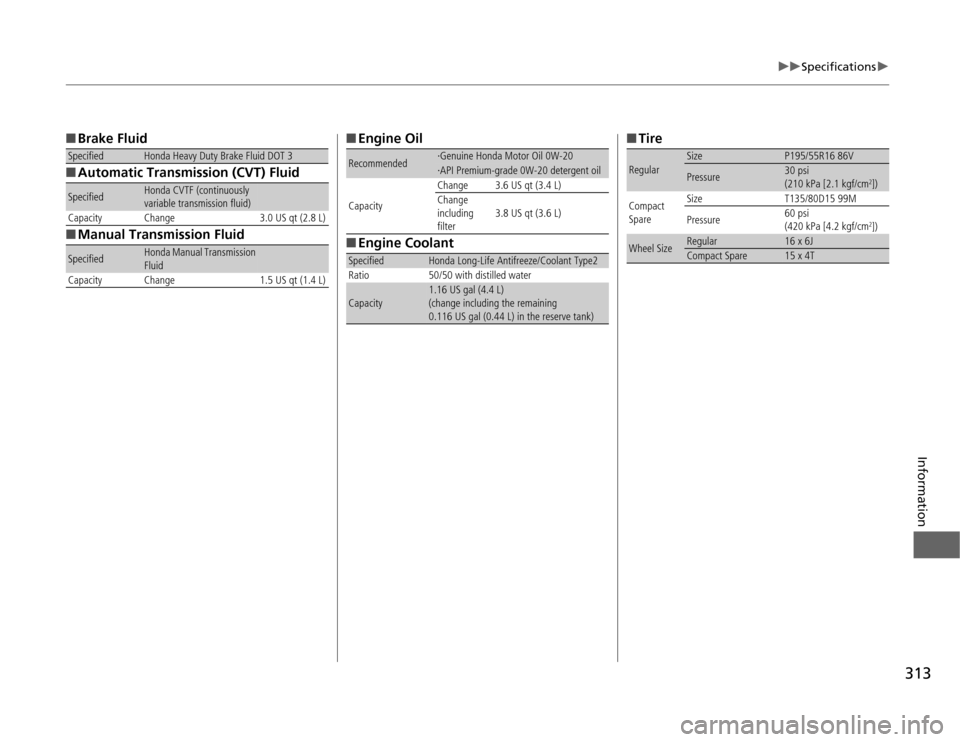
313
uuSpecificationsu
Information
■Brake Fluid
■Automatic Transmission (CVT) Fluid
■Manual Transmission Fluid
SpecifiedHonda Heavy Duty Brake Fluid DOT 3
SpecifiedHonda CVTF (continuously
variable transmission fluid)
Capacity Change 3.0 US qt (2.8 L)
SpecifiedHonda Manual Transmission Fluid
Capacity Change 1.5 US qt (1.4 L)
■Engine Oil
■Engine Coolant
Recommended·Genuine Honda Motor Oil 0W-20
·API Premium-grade 0W-20 detergent oil
Capacity Change 3.6 US qt (3.4 L)
Change
including filter
3.8 US qt (3.6 L)
SpecifiedHonda Long-Life Antifreeze/Coolant Type2
Ratio 50/50 with distilled water
Capacity
1.16 US gal (4.4 L)
(change including the remaining
0.116 US gal (0.44 L) in the reserve tank)
■Tire
Regular
SizeP195/55R16 86V
Pressure30 psi
(210 kPa [2.1 kgf/cm 2
])
Compact
Spare Size T135/80D15 99M Pressure
60 psi
(420 kPa [4.2 kgf/cm
2
])
Wheel SizeRegular16 x 6J
Compact Spare15 x 4T
Page 315 of 333
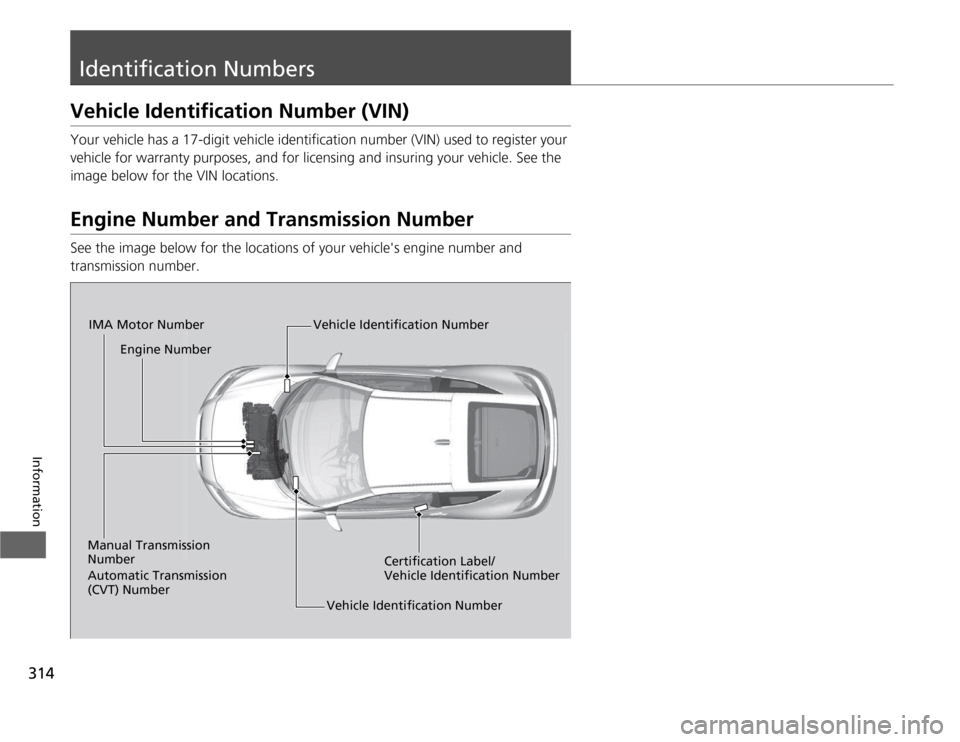
314
Information
Identification Numbers
Vehicle Identification Number (VIN)
Your vehicle has a 17-digit vehicle identification number (VIN) used to register your
vehicle for warranty purposes, and for licensing and insuring your vehicle. See the
image below for the VIN locations.
Engine Number and Transmission Number
See the image below for the locations of your vehicle's engine number and transmission number.
Vehicle Identification Number
Engine Number
Certification Label/
Vehicle Identification Number
Manual Transmission
Number
Automatic Transmission
(CVT) Number IMA Motor Number
Vehicle Identification Number
Page 316 of 333
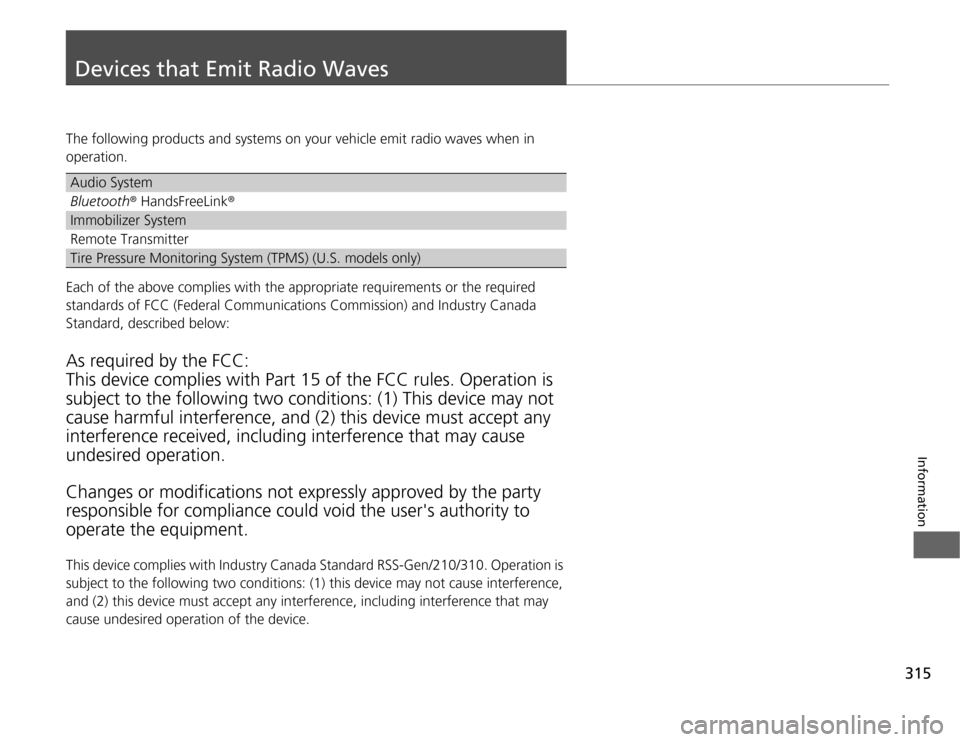
315
Information
Devices that Emit Radio Waves
The following products and systems on your vehicle emit radio waves when in
operation.
Each of the above complies with the appropriate requirements or the required
standards of FCC (Federal Communications Commission) and Industry Canada
Standard, described below: As required by the FCC: This device complies with Part 15 of the FCC rules. Operation is subject to the following two conditions: (1) This device may not
cause harmful interference, and (2) this device must accept any interference received, i ncluding interference that may cause
undesired operation. Changes or mo difications not expressly approved by the party
responsible for compliance could void the user's authority to operate the equipment.
This device complies with Industry Canada Standard RSS-Gen/210/310. Operation is
subject to the following two conditions: (1) this de vice may not cause interference,
and (2) this device must accept any interference, including interference that may
cause undesired operation of the device.
Audio System
Bluetooth ® HandsFreeLink ®
Immobilizer System
Remote Transmitter
Tire Pressure Monitoring System (TPMS) (U.S. models only)
Page 317 of 333
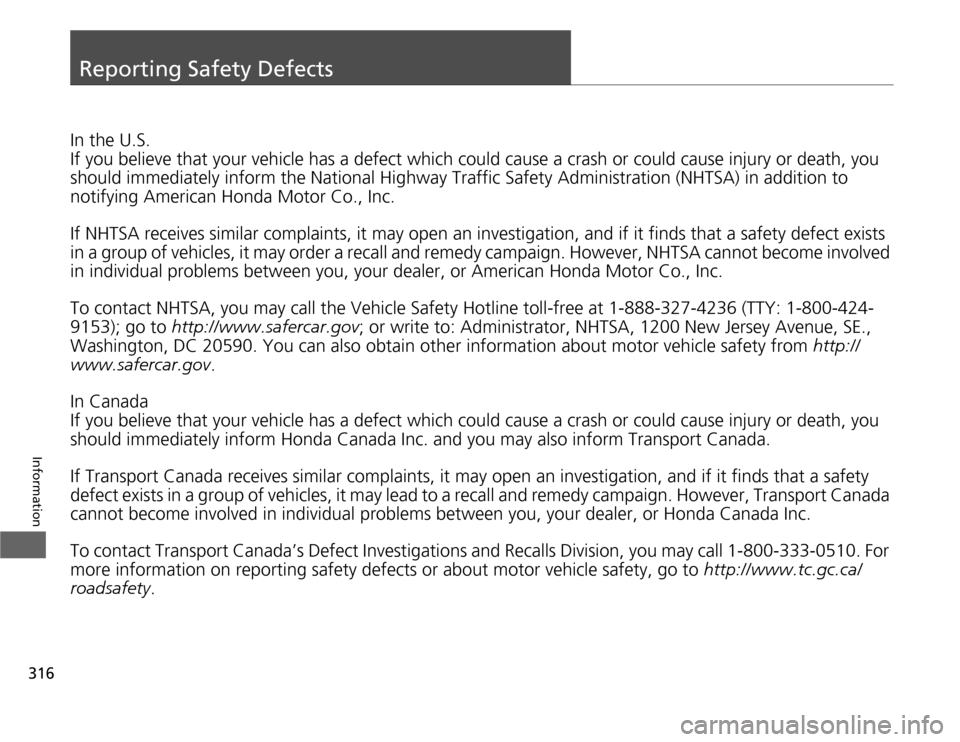
316
Information
Reporting Safety Defects
In the U.S. If you believe that your vehicle has a defect which could cause a crash or could cause injury or death, you
should immediately inform the National Highway Traffic Safety Administration (NHTSA) in addition to
notifying American Honda Motor Co., Inc.
If NHTSA receives similar complaints, it ma y open an investigation, and if it finds that a safety defect exists
in a group of vehicles, it may or der a recall and remedy campaign. However, NHTSA cannot become involved
in individual problems between you, your dealer, or American Honda Motor Co., Inc.
To contact NHTSA, you may call the Vehicle Safety Hotline toll-free at 1-888-327-4236 (TTY: 1-800-424- 9153); go to http://www.safercar.gov ; or write to: Administrator, NHTSA, 1200 New Jersey Avenue, SE.,
Washington, DC 20590. You can also obtain other information about motor vehicle safety from http://
www.safercar.gov .
In CanadaIf you believe that your vehicle has a defect which could cause a crash or could cause injury or death, you
should immediately inform Honda Canada Inc. and you may also inform Transport Canada.
If Transport Canada receives simi lar complaints, it may open an investigation, and if it finds that a safety
defect exists in a group of vehicles, it may lead to a reca ll and remedy campaign. However, Transport Canada
cannot become involved in individ ual problems between you, your dealer, or Honda Canada Inc.
To contact Transport Canada’s Defect Investigations and Recalls Division, you may call 1-800-333-0510. For
more information on reporting safety defects or about motor vehicle safety, go to http://www.tc.gc.ca/
roadsafety .
Page 318 of 333
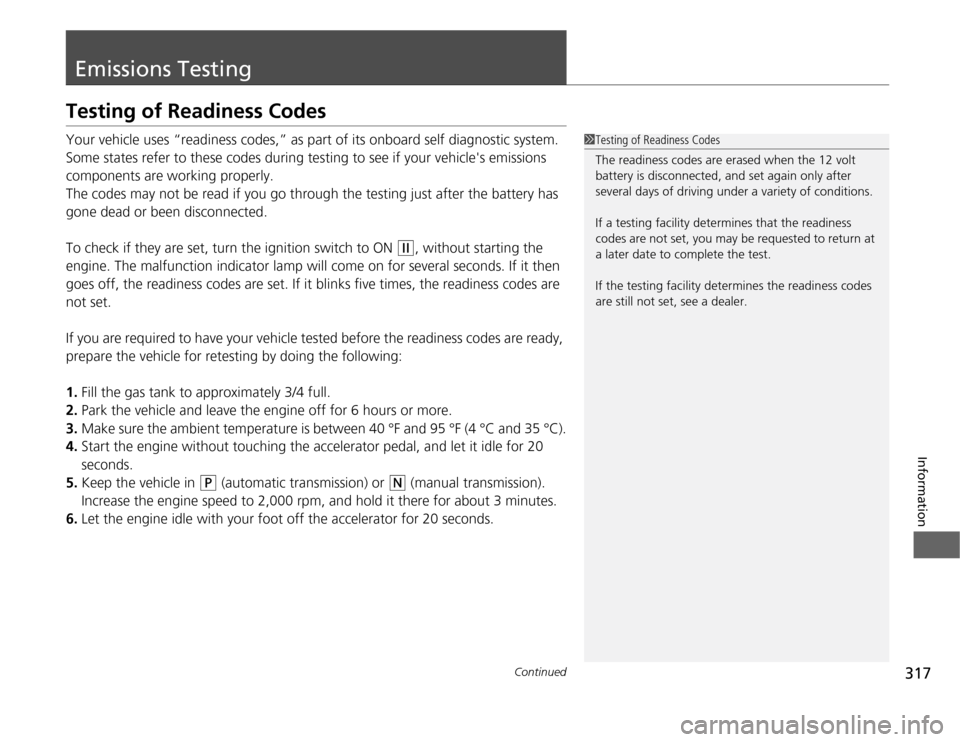
317
Continued
Information
Emissions Testing
Testing of Readiness Codes
Your vehicle uses “readiness codes,” as part of its onboard self diagnostic system.
Some states refer to these codes during testing to see if your vehicle's emissions
components are working properly.
The codes may not be read if you go through the testing just after the battery has
gone dead or been disconnected.
To check if they are set, turn the ignition switch to ON
(w
, without starting the
engine. The malfunction indicator lamp will come on for several seconds. If it then
goes off, the readiness codes are set. If it blinks five times, the readiness codes are not set.
If you are required to have your vehicle tested before the readiness codes are ready,
prepare the vehicle for retesting by doing the following:
1. Fill the gas tank to approximately 3/4 full.
2. Park the vehicle and leave the engine off for 6 hours or more.
3. Make sure the ambient temperature is between 40 °F and 95 °F (4 °C and 35 °C).
4. Start the engine without touching the accelerator pedal, and let it idle for 20 seconds.
5. Keep the vehicle in
(P (automatic transmission) or (N (manual transmission).
Increase the engine speed to 2,000 rpm, and hold it there for about 3 minutes.
6. Let the engine idle with your foot off the accelerator for 20 seconds.
1Testing of Readiness Codes
The readiness codes are erased when the 12 volt
battery is disconnected, and set again only after
several days of driving under a variety of conditions.
If a testing facility dete rmines that the readiness
codes are not set, you may be requested to return at
a later date to complete the test.
If the testing faci lity determines the readiness codes
are still not set, see a dealer.
Page 319 of 333

318
uuEmissions TestinguTesting of Readiness Codes
Information
7.Select a nearby, lightly traveled major highway where you can maintain a speed
of 50 to 60 mph (80 to 97 km/h) for at least 20 minutes. Drive on the highway in
(D (automatic) or 5th (manual). Do not use cruise control. When traffic allows,
drive for 90 seconds without moving the accelerator pedal. (Vehicle speed may
vary slightly; this is okay.) If you cannot do this for a continuous 90 seconds
because of traffic conditions, drive for at least 30 seconds, then repeat it two
more times (for a total of 90 seconds).
8. Drive in city/suburban traffic for at least 10 minutes. When traffic conditions
allow, let the vehicle coast for several seconds without using the accelerator pedal
or the brake pedal.
9. Park the vehicle and leave the engine off for 30 minutes.
Page 320 of 333
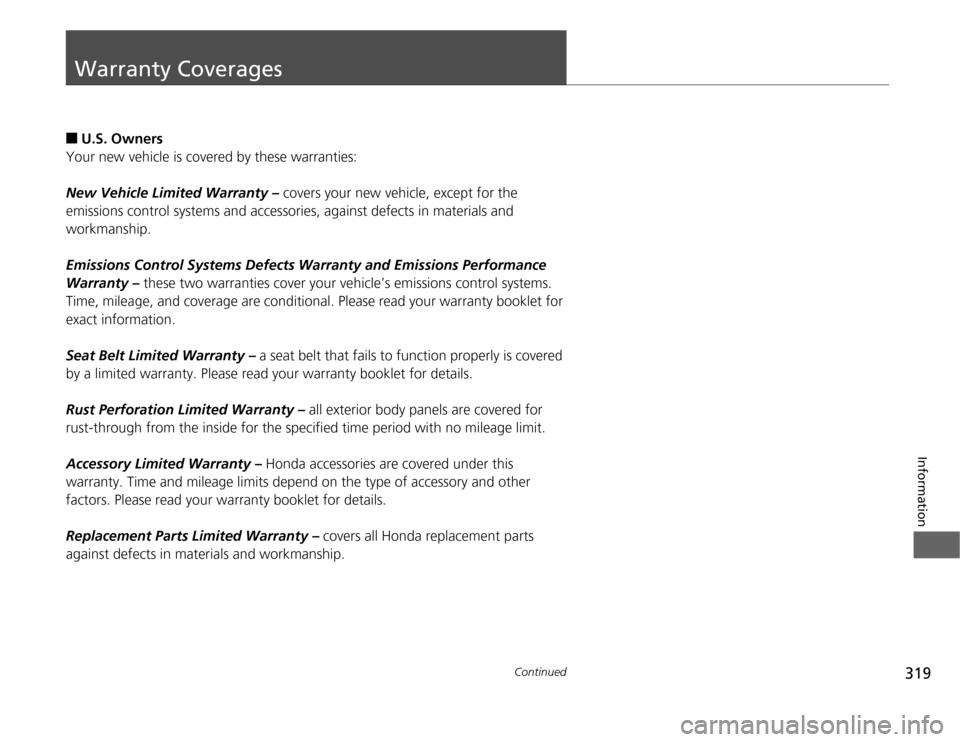
319
Continued
Information
Warranty Coverages
■
U.S. Owners
Your new vehicle is covered by these warranties:
New Vehicle Limited Warranty – covers your new vehicle, except for the
emissions control systems and accessories, against defects in materials and
workmanship.
Emissions Control Systems Defects Warranty and Emissions Performance
Warranty – these two warranties cover your vehicle’s emissions control systems.
Time, mileage, and coverage are conditional. Please read your warranty booklet for
exact information.
Seat Belt Limited Warranty – a seat belt that fails to function properly is covered
by a limited warranty. Please read your warranty booklet for details.
Rust Perforation Limited Warranty – all exterior body panels are covered for
rust-through from the inside for the specified time period with no mileage limit.
Accessory Limited Warranty – Honda accessories are covered under this
warranty. Time and mileage limits depend on the type of accessory and other
factors. Please read your warranty booklet for details.
Replacement Parts Limited Warranty – covers all Honda replacement parts
against defects in materials and workmanship.